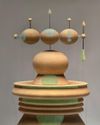
Fouzdar House, situated in Navrangpura, an older suburb of Ahmedabad, has seen better days. It stands in a neighbourhood that has over the years given way to high-rise buildings. Built in 1971 by the current owner’s grandfather with a local architect, it was meant as a safe haven for both of his sons. It’s for nostalgia, perhaps, and the memory of their grandfather, that the family decided not to redevelop the place but to renovate it, stay true to its essential character, and preserve its beauty for themselves, as well as family and friends.
Built in a modernist style with clean lines, spacious rooms, and adjoining bathrooms, this six-bedroom home, with verandas generously added on all sides to allow for cross-ventilation and light, has survived with its good bones for 50 years now. The owners were careful with their choice of architect—someone whose interventions would be minimal and sensitive. So Kunal Shah, a designer and a friend of the family, was invited. Shah’s journey, as he himself continues to discover over time, has been about the relationship between austerity and opulence.
As you enter the compound, you glimpse the home surrounded by Ashoka trees. The original terrazzo floors have been restored almost throughout, except in parts where it was too damaged—for instance, the veranda, where it was replaced with a complementary smallcut kota stone that is locally available.
“Ahmedabad is a very dusty city. In Gujarati we say, ‘dhuliyo gaam’, a dusty village, and Kota stone is forgiving,” says Shah. On the veranda, hangs an expertly crafted, Nakashima-inspired swing by Maneesh Jangid, a master carpenter.
Esta historia es de la edición May - June 2024 de AD Architectural Digest India.
Comience su prueba gratuita de Magzter GOLD de 7 días para acceder a miles de historias premium seleccionadas y a más de 9,000 revistas y periódicos.
Ya eres suscriptor ? Conectar
Esta historia es de la edición May - June 2024 de AD Architectural Digest India.
Comience su prueba gratuita de Magzter GOLD de 7 días para acceder a miles de historias premium seleccionadas y a más de 9,000 revistas y periódicos.
Ya eres suscriptor? Conectar

AS NEW DELHI'S GALLERY ESPACE MARKS ITS 35TH ANNIVERSARY, AD LOOKS AT GALLERIST RENU MODI'S JOURNEY IN ART.
The New Delhi-based Gallery Espace, founded by Renu Modi in 1989, recently marked its 35th anniversary with two special exhibitions.

ROCHELLE PINTO, EDITOR OF VOGUE INDIA, WRITES ABOUT FORCES OF FASHION, WHICH PUT 39 UNIQUE WORKS UNDER ONE ROOF, PIECING TOGETHER A SHORT HISTORY OF FASHION IN INDIA.
If you want to step into the mind of Cristóbal Balenciaga, the game-changing Spanish couturier who died over 50 years ago, all you have to do is beg, bribe or charm your way into 10 Avenue George V in Paris.

AS INVISIBLE COLLECTION COMES TO INDIA, FOUNDERS ISABELLE DUBERNMALLEVAYS AND LILY FROEHLICHER SHARE THEIR SERENDIPITOUS JOURNEY TO THE COUNTRY.
Isabelle Dubern-Mallevays and Lily Froehlicher first found India at their doorstep when Sonam Kapoor Ahuja borrowed a few pieces from their collection for an AD India cover story in 2021.

ANONYMOUS ARTIST PRINCESS PEA SHOWCASES A COLLECTION OF NINE NEW PRINTS AT THE SOHO HOUSE LOUNGE AT ART MUMBAI.
In Princess Pea's new collection of works, poetry, craft and the divine femininity coalesce with grace.

ARTISTS RITU AND SURYA SINGH'S WONDERLAND OF A HOMESTUDIO IN THE PINK CITY URGES YOU TO LOOK AT THE BEAUTY AND NARRATIVE OF WASTE.
Husband-wife artist duo Ritu and Surya Singh, better known as Wolf, live at \"The Farm\", a unique 20-acre madhouse of wonders in the heart of Jaipur.

KENGO KUMA TALKS TO AD ABOUT HIS DESIGN ADDITIONS AS THE CENTRO DE ARTE MODERNA GULBENKIAN IN LISBON OPENS ITS DOORS AGAIN.
Everyone who has lived in Lisbon likely has a fond memory of the Gulbenkian complex.

FROM HIS REVERENCE FOR GANDHI TO HIS LOVE OF DANCE, A BOOK BY DAG OFFERS NEW WAYS TO KNOW MF HUSAIN.
If there was ever an Indian artist who earned immense fame and yet remained unknowable, it is MF Husain.

WHAT WOULD BAWA DO? WONDERS APARNA RAO, COFOUNDER OF PHANTOM HANDS, AS SHE PRODUCES REISSUES OF GEOFFREY BAWA'S HIGHLY CONTEXTUAL FURNITURE.
In mid-December last year, in the freshly restored Kannangara House designed by Geoffrey Bawa in 1959, an exhibition based on the late Sri Lankan master's furniture designs opened.

BANGLADESHI ARTIST AYESHA SULTANA'S RECENT DUBAI EXHIBITION EXPLORED THE DUAL NATURE OF STRENGTH AND FRAGILITY.
Born in Bangladesh in 1984, the US-based Ayesha Sultana explores notions of form, space and materiality.

WE CATCH UP WITH TARIK CURRIMBHOY AT HIS STUDIO IN NEW YORK, AFTER HIS FIRST SOLO SHOW IN INDIA.
Tarik Currimbhoy's sculptures have a pure, meditative quality. A viewer can stand mesmerized for hours watching the elegant, geometric shapes move back and forth.